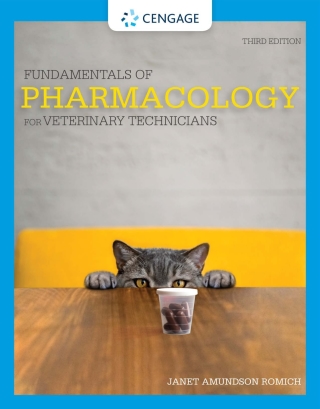Buy Fundamentals of Pharmacology for Veterinary Technicians, 3rd Edition PDF ebook by author Janet Amundson Romich; Sarah Wagner – published by Cengage Learning in 2021 and save up to 80% compared to the print version of this textbook. With PDF version of this textbook, not only save you money, you can also highlight, add text, underline add post-it notes, bookmarks to pages, instantly search for the major terms or chapter titles, etc.
You can search our site for other versions of the Fundamentals of Pharmacology for Veterinary Technicians, 3rd Edition PDF ebook. You can also search for others PDF ebooks from publisher Cengage Learning, as well as from your favorite authors. We have thousands of online textbooks and course materials (mostly in PDF) that you can download immediately after purchase.
Note: e-textBooks do not come with access codes, CDs/DVDs, workbooks, and other supplemental items.
eBook Details:
Full title: Fundamentals of Pharmacology for Veterinary Technicians, 3rd Edition
Edition: 3rd
Copyright year: 2021
Publisher: Cengage Learning
Author: Janet Amundson Romich; Sarah Wagner
ISBN: 9780357361474, 9780357461648
Format: PDF
Description of Fundamentals of Pharmacology for Veterinary Technicians, 3rd Edition:
Romich’s FUNDAMENTALS OF PHARMACOLOGY FOR VETERINARY TECHNICIANS, 3E demonstrates how the best veterinary technicians succeed on the frontlines of animal patient care through effective drug administration. Following a body-systems approach, chapters cover important drugs, their actions and potentially adverse effects, diseases, dosing, and delivery — all with the goal of developing a deeper understanding of drugs used in veterinary care. To bring practice into the classroom, chapters also explore veterinary technician roles and duties, dosage calculations, legal requirements, pharmacy management, clinical tips and more. And the MindTap platform offers extra digital resources such as practice quizzes, games, drug updates for better success in the classroom and on the VTNE certification exam.Important Notice: Media content referenced within the product description or the product text may not be available in the ebook version.
Table of Contents of Fundamentals of Pharmacology for Veterinary Technicians, 3rd Edition PDF ebook:
ContentsPrefaceChapter 1: A Brief History of Veterinary PharmacologyIntroductionA History of Veterinary PharmacologyPharmaceutical TerminologyRegulation of Drug ProductsCategories of Drug ProductsSummaryChapter ReviewChapter 2: Veterinary Drug Development and ControlIntroductionThe Stages of Veterinary Drug DevelopmentSafety and Effectiveness EvaluationSummaryChapter ReviewChapter 3: Principles and Methods of Drug AdministrationIntroductionSafe Drug UseThe Safe Zone: The Therapeutic RangeStaying in the Safe ZoneOut of the Safe ZoneSummaryChapter ReviewChapter 4: PharmacokineticsIntroductionDrug MovementPharmacokinetics Part I: Getting InPharmacokinetics Part II: Moving AroundPharmacokinetics Part III: ChangingPharmacokinetics Part IV: Getting OutMeasuring Drug ActionHow Do Drugs Work?SummaryChapter ReviewChapter 5: Veterinary Drug Use, Prescribing, Acquisition, and Pharmacy ManagementIntroductionBrand Name () or Not?CompoundingGetting InformationDrug StandardsPackage InsertsDrug Reference MaterialThe InternetDispensing Versus PrescribingPharmacy EconomicsInventory Control and MaintenanceInventory PurchasingInventory ManagementPharmacy OrganizationDisposal of Unused/Unwanted DrugsSummaryChapter ReviewChapter 6: Systems of Measurement in Veterinary PharmacologyIntroductionThe BasicsHow Do We Measure?Converting Within SystemsConverting Among SystemsTemperature ConversionsDose CalculationsSolutionsReconstitutionSummaryChapter ReviewChapter 7: Drugs Affecting the Nervous SystemIntroductionBasic Nervous System Anatomy and PhysiologyCentral Nervous System DrugsAutonomic Nervous System DrugsSummaryChapter ReviewChapter 8: Drugs Acting on the Heart, Blood Vessels, and BloodIntroductionBasic Cardiac Anatomy and PhysiologyCardiovascular DiseaseDrugs Affecting the Heart and Blood VesselsDrugs Affecting BloodSummaryChapter ReviewChapter 9: Respiratory System DrugsIntroductionBasic Respiratory Anatomy and PhysiologyRespiratory ConditionsRespiratory DrugsCommon Respiratory DiseasesSummaryChapter ReviewChapter 10: Hormonal and Reproductive DrugsIntroductionBasic Endocrine System Anatomy and PhysiologyHormonal DrugsBasic Reproductive System Anatomy and PhysiologyDrugs Affecting ReproductionSummaryChapter ReviewChapter 11: Gastrointestinal DrugsIntroductionBasic Digestive System Anatomy and PhysiologyGastrointestinal DisordersGastrointestinal DrugsSummaryChapter ReviewChapter 12: Urinary System DrugsIntroductionBasic Urinary System Anatomy and PhysiologyUrinary System DisordersUrinary System DrugsSummaryChapter ReviewChapter 13: Drugs Used to Treat Musculoskeletal DysfunctionIntroductionBasic Muscle Anatomy and PhysiologyMuscle DisordersDrugs Affecting Skeletal MuscleSummaryChapter ReviewChapter 14: Antimicrobial DrugsIntroductionPathogenic Microbes and Infectious Animal DiseaseAntimicrobial TerminologyAntibiotic Drugs (Antimicrobial Therapy of Bacterial Infections)Classes of Antibiotic DrugsPromoting GrowthAntifungal Drugs (Antimicrobial Therapy of Fungal Infections)Antiviral Drugs (Antimicrobial Therapy of Viral Infections)Controlling Growth of MicroorganismsSummaryChapter ReviewChapter 15: Antiparasitic DrugsIntroductionParasites and Animal DiseaseTypes of ParasitesEndoparasitesAntiparasitic DrugsHeartworm Disease Prevention and TreatmentEctoparasitesEctoparasite DrugsSummaryChapter ReviewChapter 16: Anti-Inflammatory and Pain-Reducing DrugsIntroductionInflammationAnti-Inflammatory Drugs (Inflammation Reducers)Analgesics (Pain Relievers)ImmunomodulatorsSummaryChapter ReviewChapter 17: Drugs for Skin ConditionsIntroductionBasic Skin Anatomy and PhysiologySkin ConditionsDrugs Used in the Treatment of Skin DisordersHoof ConditionsConditions of Uncontrolled GrowthSummaryChapter ReviewChapter 18: Ophthalmic and Otic MedicationsIntroductionBasic Ocular System Anatomy and PhysiologyOphthalmic DrugsBasic Ear Anatomy and PhysiologyOtic MedicationsSummaryChapter ReviewChapter 19: Fluid Therapy and Emergency DrugsIntroductionBasics of Body FluidFluid TherapyHow Do We Get It There?What Can We Give?What Can We Add?How Much Do We Give?Examples of Fluid CalculationsHow Fast Do We Give It?What Do We Use to Give It?Keeping WatchCardiopulmonary Cerebral Resuscitation (CPCR) and Emergency DrugsSummaryChapter ReviewChapter 20: Antineoplastic and Immunomodulatory DrugsIntroductionNeoplasmsAntineoplastic Drugs (Cancer-Fighting Drugs)Cancer PainSummaryChapter ReviewChapter 21: VaccinesIntroductionProtection Against DiseaseWhat Is a Vaccine?Issues of Vaccine UseVaccine ProtocolsVaccine ExamplesSummaryChapter ReviewChapter 22: Behavior-Modifying DrugsIntroductionBehavior Problems in AnimalsClasses of Behavior-Modifying DrugsSummaryChapter ReviewChapter 23: Herbal TherapeuticsIntroductionAlternativesWhat’s in a Name?West Versus EastHerbal CountdownAdvice To ClientsSummaryChapter ReviewAppendix A: Proper Use of Needles and SyringesAppendix B: Reconstituting a Powder Medication for AdministrationAppendix C: Withdrawing (Aspirating) Medication from a Vial*Appendix D: Withdrawing (Aspirating) Medication from an AmpuleAppendix E: The Dos and Don’ts of Drug AdministrationAppendix F: Inventory ManagementAppendix G: Unit Conversions and Math ReferencesAppendix H: Conversion of Body Weight in Kilograms to Body Surface Area in Meters (for Dogs and CatsAppendix I: Metric Conversions GuideAppendix J: Mathematics ReviewAppendix K: Constant Rate Infusion (CRI) CalculationsAppendix L: Euthanasia ProcedureAppendix M: Vitamin SupplementsAppendix N: Managing Animal ToxicitiesAppendix O: Drugs People Should Avoid During PregnancyAppendix P: Drugs Listed Alphabetically and Classified by CategoryGlossaryIndex





